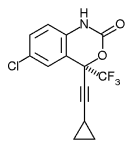In 2003 researchers stopped a clinical trial abruptly when they found that a combination of three drugs that seemed likely to work well together failed to control the virus in many patients, and led to a very high rate of viral resistance; a comparison regimen that used efavirenz instead of the tenofovir worked well. A similar combination (tenofovir plus abacavir plus ddI) also failed. However, regimens that include AZT do not fail in this way. The problem was completely unexpected, and since it occurred, several different theories were proposed.
No one knows the answer for sure--and we will probably never know, since it would be unethical to test the failed triple combinations in patients with HIV. But many researchers now believe the most likely explanation is that the drug combinations failed to control the virus because of a low genetic barrier to HIV resistance. Two mutations that developed in this trial protect the virus against the three drugs.
The December 1, 2005 Journal of Infectious Diseases published the full report of the trial [1] and a commentary [2]; both are available free online.
"The most likely explanation is the low genetic barrier to resistance produced by synergistic selection pressure from all 3 drugs for 2 point mutation, M184V and K65R. Both abacavir and tenofovir DF select for the K65R mutation, which reduces susceptibility to both drugs, as well as to lamivudine [3TC]. M184V is selected for by lamivudine and abacavir, and it decreases susceptibility to both. Thus, the selection of 2 mutations, each of which may preexist as minority species, leads to virologic failure with this regimen." [1]
The authors conclude that physicians should not try new combinations on their own as the first antiretroviral treatment for patients. "Given the growing number of potent, well-studied combinations now available, there is no longer a rationale for the use of untested regimens outside of clinical trials in the treatment of therapy-naive HIV-infected patients." [1]
References
Note: Both articles below were made available free online by the journal; you do not need to be a subscriber.
They are available through the Table of Contents of the December 1 issue, http://www.journals.uchicago.edulJID/journal/contents/v192n11.html
(1.) Gallant JE, Rodriguez AE, Weinberg WG, and others. for the ESS30009 study. Early virologic nonresponse to tenofovir, abacavir, and lamivudine in HIV-infected antiretroviral-naive subjects. Journal of Infectious Diseases. December 1,2005; volume 192, pages 1921-1930.
(2.) Kuritzkes DR. Less than the sum of its parts: Failure of a tenofovir-abacavir-lamivudine triple-nucleoside regimen. Editorial commentary. Journal of Infectious Diseases. December 1,2005; volume 192, pages 1867-1868.
COPYRIGHT 2005 John S. James
COPYRIGHT 2005 Gale Group



